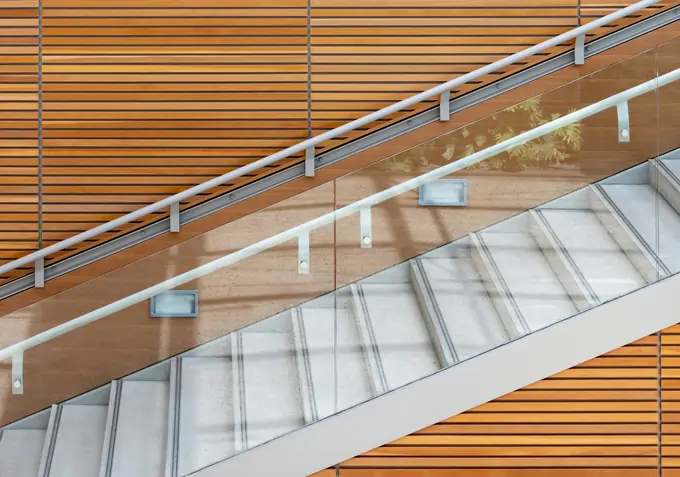Handrails provide essential safety and support for stairs, decks, and outdoor steps.
They offer a secure grip, preventing falls and accidents.
Metal Handrails for stairs, such as aluminum handrail, black stair handrails, and steel pipe handrails, are durable choices for both interior or exterior applications.
What Makes a Handrail Durable for Stairs?
Durable handrails for stairs must withstand constant use, exposure to elements, and potential impacts.
It should be crafted from high-quality materials resistant to corrosion, weathering, and wear.
The installation method and components also contribute to the handrail’s longevity.
How to Choose a Durable Metal Handrail
Evaluate the metal type, thickness, and finish for durability.
Stainless steel, aluminum, and galvanized steel are excellent choices for outdoor handrails.
Opt for a sturdy design with secure fittings and brackets.
Wall-mounted handrails or those with multiple posts offer superior stability.
Benefits of Stainless Steel Handrails for Stairs
Stainless steel handrails are a perfect option for both residential and commercial stairways.
They resist rust, corrosion, and discoloration, even in harsh environments.
Stainless steel is also easy to clean and maintain, ensuring a long-lasting appearance.
Comparing Metal Handrails to Wood Handrails in Durability
While straight wood handrails like red oak offer a stylish look, they may require more maintenance and are susceptible to weathering.
Metal handrails, such as aluminum or iron hand rails, are more durable and resistant to moisture, rot, and insect damage.
How to Install a Steel Handrail for Outdoor Steps?

Proper installation is crucial for a secure and long-lasting handrail system.
Following the manufacturer’s instructions and local building codes is essential.
Many handrail kits, like those from VEVOR, offer easy installation with pre-cut components and hardware.
Step-by-Step Guide for Handrail Installation
- Measure and mark the desired handrail length and mounting locations.
- Cut the handrail to size, if necessary, using appropriate tools.
- Attach the mounting brackets or posts to the stairs or wall, following the manufacturer’s specifications.
- Secure the handrail to the brackets or posts using the provided fittings and hardware.
- Install any additional components, such as end caps or volutes (decorative turns).
- Ensure the handrail is level, sturdy, and meets local code requirements.
Required Tools and Materials
- Measuring tape
- Level
- Drill
- Saw (for cutting the handrail, if needed)
- Wrenches or pliers
- Handrail kit (including the rail, brackets, fittings, and hardware)
- Concrete anchors (for mounting to masonry surfaces)
Safety Tips During Installation
- Follow all safety instructions provided by the manufacturer.
- Use proper personal protective equipment, such as gloves and safety glasses.
- Ensure a stable and secure work platform when working at heights.
- Have an assistant to help with lifting and positioning the handrail components.
What are the Best Materials for Sturdy Handrails?
The material choice for handrails depends on factors like durability, aesthetics, and budget.
Popular options include stainless steel, aluminum, wrought iron, and galvanized steel.
Each material offers unique advantages and characteristics.
Advantages of Steel Handrails
Steel handrails are incredibly strong and long-lasting, making them suitable for high-traffic areas.
They can withstand heavy impacts and are resistant to dents and scratches.
Steel handrails are also relatively affordable compared to other metal options.
Comparing Aluminum and Wrought Iron Handrails
Aluminum handrails are lightweight yet durable, making them easy to install and maintain.
They resist corrosion and are available in various finishes, including brushed or anodized.
Wrought iron handrails offer a classic, elegant look but require more maintenance to prevent rusting.
Choosing the Right Finish for Your Handrail

The finish plays a crucial role in the handrail’s appearance and durability.
Powder-coated finishes provide a sleek, matte black or colored surface resistant to fading and scratches.
Brushed or satin finishes offer a contemporary touch while hiding minor imperfections.
How to Maintain Handrails for Outdoor Use?
Proper maintenance is essential to ensure the longevity and safety of outdoor handrails.
Regular cleaning and weatherproofing can prevent premature deterioration and extend the handrail’s lifespan.
Cleaning and Upkeep for Metal Handrail
Use a mild detergent and soft-bristle brush to remove dirt, grime, and surface stains.
Avoid abrasive cleaners that can scratch or dull the finish.
Rinse thoroughly and dry the handrail after cleaning to prevent water spots or streaks.
Weatherproofing Your Handrails
Apply a clear, protective sealant or wax to metal handrails to enhance their resistance to moisture and environmental factors.
Reapply the sealant or wax periodically, following the manufacturer’s recommendations.
What are ADA Compliance Requirements for Handrailings?
Handrails for stairs and ramps must meet specific guidelines outlined by the Americans with Disabilities Act (ADA) to ensure accessibility and safety for individuals with disabilities.
Understanding ADA Guidelines for Stairs
The ADA requires handrails on both sides of stairs with a rise greater than 6 inches or a horizontal run longer than 72 inches.
The handrails must be continuous, with a height between 34 and 38 inches measured vertically from the stair nosing.
ADA Compliance for Indoor and Outdoor Handrails
Both indoor and outdoor handrails must comply with ADA standards, including height, gripping surface, and clearance requirements.
Outdoor handrails may need additional weatherproofing or slip-resistant surfaces to accommodate environmental conditions.
Where Can You Purchase Durable Handrails?
Durable handrails for stairs are available from various sources, including online retailers, home improvement stores, and local suppliers.
Many reputable brands, such as VEVOR, offer high-quality handrail kits with free shipping for residential and commercial projects.
Top Online Stores Offering Free Shipping
- Amazon
- Home Depot
- Lowe’s
- Wayfair
- Build.com
How to Identify a Quality Handrail Kit
Look for handrail kits made from durable materials like stainless steel or aluminum.
Ensure the kit includes all necessary components, such as brackets, fittings, and hardware.
Read customer reviews and product descriptions to assess the kit’s ease of installation and overall quality.
Local Suppliers for Handrails
Check with local hardware stores, lumber yards, or metal fabricators for handrail options.
Local suppliers may offer custom sizing, finishes, or installation services.
Comparing prices and quality across multiple sources can help you find the best deal.
Remember, investing in a durable and properly installed handrail can elevate the safety and aesthetic appeal of your stairs, decks, and outdoor spaces.
People Ask
What is the difference between stair rails and handrails?
Alright, so here’s the lowdown on the difference between stair rails and handrails.
Stair rails usually run along the side of the staircase and can be made from materials like black aluminum or black iron. They’re meant to keep you from falling off.
Handrails, on the other hand, are things you hold onto when going up or down stairs. You can get a nice black handrail that’s wall mounted for inside your home. There are also options like deck handrails for outside.
How high does a handrail have to be on steps?
Hey, wondering about handrail heights for steps? For homes and commercial setups, it generally should be around 34″-38″ above the step. But hey, width can be adjustable! Using cable railing kits could be a sleek choice, mixing decor with safety.
If you’re into DIY, installing a cable railing on a metal stair or iron stair is pretty doable. Most kits even let you upgrade and enjoy free shipping!
Just remember, height rules may vary—aim for around 34″-38″ or roughly 3 ft with a 1.5 inch grip. You can also opt for a fancy volute or stick to a single post!
What side of stairs should railing be on?
When it comes to which side of the stairs the railing should be on, it really may vary based on preference and design. A neat idea is to install a railing on both sides to make it super safe, you know, like a pair. Plus, it’s more likely to be compliant with building codes that way!
How many steps can you have without a handrail?
Hey, ever wondered how many steps you can have without needing handrails for stairs? There’s actually a rule for that! If you’ve got less than four steps, you’re good to go without handrails for stairs. But anything more than that, and you definitely need handrails for stairs for safety.


